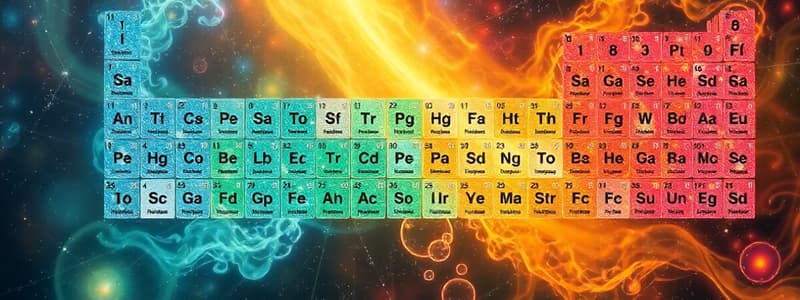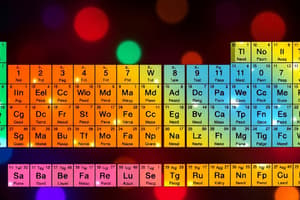Podcast
Questions and Answers
What does the atomic number of an element represent?
What does the atomic number of an element represent?
- Total mass of the atom
- Number of electrons in a neutral atom
- Number of protons in the nucleus (correct)
- Number of neutrons in the nucleus
All elements in the periodic table are metals.
All elements in the periodic table are metals.
False (B)
In which order are chemical elements arranged in the periodic table?
In which order are chemical elements arranged in the periodic table?
Ascending atomic number
Elements are categorized into three main types: metals, metalloids, and ______.
Elements are categorized into three main types: metals, metalloids, and ______.
Match the following groups to their characteristics:
Match the following groups to their characteristics:
What color does phenolphthalein turn in basic conditions?
What color does phenolphthalein turn in basic conditions?
Alkali metals can be found in nature in their pure form.
Alkali metals can be found in nature in their pure form.
What must alkali metals be stored in to prevent reaction with the air?
What must alkali metals be stored in to prevent reaction with the air?
Phenolphthalein is ____ in acidic conditions.
Phenolphthalein is ____ in acidic conditions.
Match the following groups with their descriptions:
Match the following groups with their descriptions:
Which of the following is NOT one of the noble gases?
Which of the following is NOT one of the noble gases?
Noble gases comprise about 1% of the Earth's atmosphere.
Noble gases comprise about 1% of the Earth's atmosphere.
In what year were noble gases discovered?
In what year were noble gases discovered?
The noble gases are located in Group ______ of the periodic table.
The noble gases are located in Group ______ of the periodic table.
Match the following noble gases with their symbols:
Match the following noble gases with their symbols:
What is the role of elements in Groups 3 through 12?
What is the role of elements in Groups 3 through 12?
Transition metals can use two of their outermost orbitals to bond with other elements.
Transition metals can use two of their outermost orbitals to bond with other elements.
Which groups comprise the most metallic elements?
Which groups comprise the most metallic elements?
Elements in Group 18 are known as __________.
Elements in Group 18 are known as __________.
Which of the following elements is NOT considered an actinide?
Which of the following elements is NOT considered an actinide?
Actinide series elements are all non-radioactive.
Actinide series elements are all non-radioactive.
What is the symbol used to refer to any of the actinide series elements?
What is the symbol used to refer to any of the actinide series elements?
The actinide series elements range from atomic numbers _____ to _____.
The actinide series elements range from atomic numbers _____ to _____.
Match the following properties with their descriptions:
Match the following properties with their descriptions:
What characteristic of alkali metals makes them reactive with halogens?
What characteristic of alkali metals makes them reactive with halogens?
Halogens are typically found in their pure, elemental form in nature.
Halogens are typically found in their pure, elemental form in nature.
What form do halogens exist in under normal conditions?
What form do halogens exist in under normal conditions?
The halogens desperately want to gain one more __________.
The halogens desperately want to gain one more __________.
Match the halogens with their diatomic molecular forms:
Match the halogens with their diatomic molecular forms:
Which of the following statements is true regarding alkali metals and halogens?
Which of the following statements is true regarding alkali metals and halogens?
All diatomic molecules are composed of different elements.
All diatomic molecules are composed of different elements.
What group do halogens belong to on the periodic table?
What group do halogens belong to on the periodic table?
Flashcards
Chemical Element
Chemical Element
A pure substance consisting of only one type of atom.
Atomic Number
Atomic Number
The number of protons in the nucleus of an atom of a specific element.
Periodic Table
Periodic Table
A chart that organizes elements by their atomic number, showing their properties and relationships.
Metals
Metals
Signup and view all the flashcards
Metalloids
Metalloids
Signup and view all the flashcards
What is phenolphthalein?
What is phenolphthalein?
Signup and view all the flashcards
What is a basic solution?
What is a basic solution?
Signup and view all the flashcards
What is an acidic solution?
What is an acidic solution?
Signup and view all the flashcards
What are alkali metals?
What are alkali metals?
Signup and view all the flashcards
How are alkali metals stored?
How are alkali metals stored?
Signup and view all the flashcards
Transition Metals
Transition Metals
Signup and view all the flashcards
Unique Bonding of Transition Metals
Unique Bonding of Transition Metals
Signup and view all the flashcards
Transition Metal Bonding Capacity
Transition Metal Bonding Capacity
Signup and view all the flashcards
What are Group 17 Elements called?
What are Group 17 Elements called?
Signup and view all the flashcards
What are Group 18 elements called?
What are Group 18 elements called?
Signup and view all the flashcards
Noble Gases
Noble Gases
Signup and view all the flashcards
Group 18
Group 18
Signup and view all the flashcards
Noble
Noble
Signup and view all the flashcards
Discovery of Noble Gases
Discovery of Noble Gases
Signup and view all the flashcards
Percentage of Noble Gases in Atmosphere
Percentage of Noble Gases in Atmosphere
Signup and view all the flashcards
Actinides
Actinides
Signup and view all the flashcards
Malleability
Malleability
Signup and view all the flashcards
Melting Point
Melting Point
Signup and view all the flashcards
Boiling Point
Boiling Point
Signup and view all the flashcards
What are halogens?
What are halogens?
Signup and view all the flashcards
Why are alkali metals reactive?
Why are alkali metals reactive?
Signup and view all the flashcards
Why are halogens reactive?
Why are halogens reactive?
Signup and view all the flashcards
Why do alkali metals and halogens bond readily?
Why do alkali metals and halogens bond readily?
Signup and view all the flashcards
What is a diatomic molecule?
What is a diatomic molecule?
Signup and view all the flashcards
How are halogens found in nature?
How are halogens found in nature?
Signup and view all the flashcards
Name some diatomic halogens.
Name some diatomic halogens.
Signup and view all the flashcards
Study Notes
Periodic Table of Elements
- A chemical element is a pure substance that is composed of only one type of atom.
- Atomic number represents the number of protons in the nucleus of an atom.
- Elements are arranged in the periodic table according to ascending atomic number.
- Elements are grouped into metals, metalloids, and nonmetals.
- Metals are typically found on the left side of the periodic table and are often conductive to electricity, malleable, shiny, and sometimes magnetic.
- Nonmetals are typically found on the right side of the periodic table and are often poor conductors of electricity, not malleable, non-shiny, and not magnetic.
- Metalloids have properties that fall between metals and nonmetals; they are typically semiconductors.
History of the Periodic Table
- Antoine Lavoisier (1743-1794) published a list of elements in 1789, which formed the basis for the modern list of elements and classified them into metals and non-metals.
- Johann Döbereiner (1780-1849) classified elements into triads (groups of three elements with related properties and weights).
- John Newlands (1837-1898) proposed the Law of Octaves, noting that elements repeated their chemical properties every eighth element, similar to octaves in music.
- Dmitri Mendeleev (1834-1907) arranged elements based on their atomic mass and observed properties, and listed similar elements in the same family/group. His table also had gaps for undiscovered elements, which turned out to be correct.
- Henry Moseley (1887-1915) arranged elements based on increasing atomic number, which was more fundamental than atomic mass.
Horizontal Rows and Vertical Columns
-
The horizontal rows on the periodic table are called periods.
-
Elements in the same period have the same number of electron orbitals.
-
There are seven periods on the table.
-
The vertical columns on the periodic table are called groups or families.
-
Elements in the same group have very similar properties and the same number of valence electrons.
-
There are 18 groups on the table.
Major Classes of Elements
- Metals, metalloids, and nonmetals are the major classes on the periodic table.
Metals
- Metals are characterized by high electrical conductivity, luster (shine), and malleability (ability to be shaped). They readily lose electrons to form positive ions (cations).
- Most of the elements on the periodic table are metals at room temperature.
Nonmetals
- Nonmetals lack metallic attributes and are good insulators of heat and electricity.
- They are typically found on the right side of the table, except for hydrogen.
Metalloids
- Metalloids have properties that fall between metals and nonmetals.
- They are often semiconductors (conduct electricity under specific conditions).
Alkali Metals
- Alkali metals are highly reactive elements found in Group 1.
- They readily lose one electron to form positive ions (cations).
- They react violently with water to form hydroxides.
Alkaline Earth Metals
- Alkaline earth metals are reactive metals in Group 2.
- They readily lose two electrons to form positive ions (cations).
- They react with water, but are less reactive than alkali metals.
Transition Metals
- Transition metals are versatile elements in Groups 3-12.
- They have valence electrons in multiple shells.
- They are used in manufacturing, construction, and the medical field.
Halogens
- Halogens are nonmetals in Group 17.
- Their reactivity decreases down the group.
- They are highly reactive and exist as diatomic molecules (two atoms per molecule) in nature.
Noble Gases
- Noble gases are chemically inert elements in Group 18.
- They have a full outermost electron shell, making them stable and largely unreactive.
- They are commonly found as monatomic (single-atom) gases.
Lanthanides
- The lanthanides are a series of metallic elements in the periodic table.
- They are also called the rare earth elements.
Actinides
- The actinides are a series of radioactive metallic elements in the periodic table (atomic numbers 89-103).
- They are also radioactive.
- They are often found in nature as radioactive elements.
Periodic Trends
- Atomic Radius: Increases down a group and to the left of the periodic table.
- Ionization Energy: Increases up a group and to the right of the periodic table.
- Electronegativity: Increases up a group and to the right of the periodic table.
- Metallic Character: Increases down a group and to the left of the periodic table.
- Ionic Radius: Cations have smaller ionic radii than their parent atoms because electrons are removed; anions have larger ionic radii than their parent atoms because electrons are added.
Studying That Suits You
Use AI to generate personalized quizzes and flashcards to suit your learning preferences.




